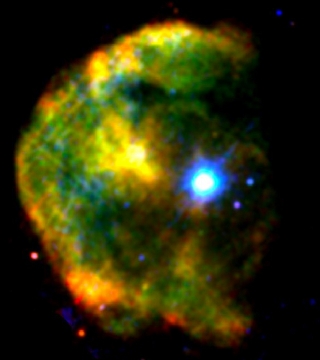May 30 2013
The physics behind some of the most extraordinary stellar objects in the Universe just became even more puzzling.

A group of astronomers led by McGill researchers using NASA's Swift satellite have discovered a new kind of glitch in the cosmos, specifically in the rotation of a neutron star.
Neutron stars are among the densest objects in the observable universe; higher densities are found only in their close cousins, black holes. A typical neutron star packs as much mass as half-a-million Earths within a diameter of only about 20 kilometers. A teaspoonful of neutron star matter would weigh approximately 1 billion tons, roughly the same as 100 skyscrapers made of solid lead.
Neutron stars are known to rotate very rapidly, from a few revolutions per minute to as fast as several hundred times per second. A neutron star glitch is an event in which the star suddenly begins rotating faster. These sudden spin-up glitches have long been thought to demonstrate that these exotic ultra-dense stellar objects contain some form of liquid, likely a superfluid.
This new cosmic glitch was detected in a special kind of neutron star – a magnetar -- an ultra-magnetized neutron star that can exhibit dramatic outbursts of X-rays, sometimes so strong they can affect the Earth's atmosphere from clear across the galaxy. A magnetar’s magnetic field is so strong that, if one were located at the distance of the Moon, it could wipe clean a credit card magnetic strip here on Earth.
Now astronomers led by a research group at McGill University have discovered a new phenomenon: they observed a magnetar suddenly rotate slower -- a cosmic braking act they've dubbed an “anti-glitch.” The result is reported in the May 30 issue of Nature.
The magnetar in question, 1E 2259+586 located roughly 10,000 light years away in the constellation of Cassiopeia, was being monitored by the McGill group using the Swift X-ray telescope in order to study the star's rotation and try to detect the occasional giant X-ray explosions that are often seen from magnetars.
"I looked at the data and was shocked -- the neutron star had suddenly slowed down," says Rob Archibald, lead author and MSc student at McGill University. "These stars are not supposed to behave this way."
Accompanying the sudden slowdown, which rang in at one third of a part per million of the 7-second rotation rate, was a large increase in the X-ray output of the magnetar, telltale evidence of a major event inside or near the surface of the neutron star.
"We've seen huge X-ray explosions from magnetars before," says Victoria Kaspi, Professor of Physics at McGill and leader of the Swift magnetar monitoring program, "but an anti-glitch was quite a surprise. This is telling us something brand new about the insides of these amazing objects." In 2002, NASA’s Rossi X-ray Timing Explorer satellite also saw a large X-ray outburst from the source, but in that case, it was accompanied by a more usual spin-up glitch.
The internal structure of neutron stars is a long-standing puzzle, as the matter inside these stars is subject to forces so intense that they are presently not re-creatable in terrestrial laboratories. The densities at the hearts of neutron stars are thought to be upwards of 10 times higher than in the atomic nucleus, far beyond what current theories of matter can describe.
The reported anti-glitch strongly suggests previously unrecognized behaviour inside neutron stars, possibly with pockets of superfluid rotating at different speeds. The researchers further point out in the Nature paper that some properties of conventional glitches have been noted to be puzzling and suggestive of flaws in the existing theory to explain them. They are hoping that the discovery of a new phenomenon will open the door to renewed progress in understanding neutron star interiors.
The research was funded in part by the Natural Sciences and Engineering Research Council of Canada, the Canadian Institute for Advanced Research, the Fonds de recherche du Québec - Nature et technologies, the Canada Research Chairs program, the Lorne Trottier Chair in Astrophysics and Cosmology, and the Centre de recherche en Astrophysique du Québec.